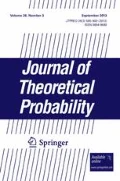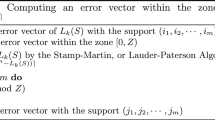Abstract
We consider a type of evolution on \(\{0,1\}^{n}\) which occurs in discrete steps whereby at each step, we replace every occurrence of the substring “01” by “10.” After at most \(n-1\) steps, we will reach a string of the form \(11\cdots 1100\cdots 00\), which we will call a “stabilized” string, and we call the number of steps required the “stabilization time.” If we choose each bit of the string independently to be a 1 with probability \(p\) and a 0 with probability \(1-p\), then the stabilization time of a string in \(\{0,1\}^{n}\) is a random variable with values in \(\{0,1,\ldots n-1\}\). We study the asymptotic behavior of this random variable as \(n\rightarrow \infty \), and we determine its limit distribution in the weak sense after suitable centering and scaling. When \(p \ne \frac{1}{2}\), the limit distribution is Gaussian. When \(p = \frac{1}{2}\), the limit distribution is a \(\chi _3\) distribution. We also explicitly compute the limit distribution in a threshold setting where \(p=p_n\) varies with \(n\) given by \(p_n = \frac{1}{2}+ \frac{\lambda / 2}{\sqrt{n}}\) for \(\lambda > 0\) a fixed parameter. This analysis gives rise to a one parameter family of distributions that fit between a \(\chi _3\) and a Gaussian distribution. The tools used in our arguments are a natural interpretation of strings in \(\{0,1\}^{n}\) as Young diagrams, and a connection with the known distribution for the maximal height of a Brownian path on \([0,1]\).
Similar content being viewed by others
Notes
University of Michigan Undergraduate Mathematics Competition 13 (1996) Problem 1. www.math.lsa.umich.edu/~hderksen/UMUMC/UMUMC13.pdf.
“A large (but finite) number of soldiers are arranged in an east–west line, and all the soldiers are facing north. The commander shouts “Right face!” One second later, all the soldiers ought to be facing east, but they have not completely mastered “right” and “left” so some are facing east and some west. Any soldier who is face-to-face with his neighbor realizes that there was a mistake and turns 180 degrees (disregarding the possibility that the mistake might have been the neighbor’s). One second later, when all these 180 degree turns have been completed, any soldier who is now face-to-face with a neighbor turns 180 degrees (even if he had just turned at the previous step). The process repeats in the same manner. Prove that it stops after finitely many steps.”
.
References
Billingsley, P.: Convergence of Probability Measures. Wiley, London (1999)
Johansson, K.: Shape fluctuations and random matrices. Commun. Math. Phys. 209, 437–476 (2000)
Karatzas, I., Shreve, S.E.: Brownian Motion and Stochastic Calculus. Springer, Berlin (1998)
Liggett, T.M.: Interacting Particle Systems. Springer, Berlin (2005)
Pitman, J.W.: One-dimensional Brownian motion and the three-dimensional Bessel process. Adv. Appl. Probab. 7, 511–526 (1975)
Rost, H.: Non-equilibrium behaviour of a many particle process: density profile and local equilibria. Zeitschrift fr Wahrscheinlichkeitstheorie und Verwandte Gebiete 58, 41–53 (1981)
Stanley, R.P.: Enumerative Combinatorics, vol. 2. Cambridge University Press, Cambridge (1999)
Stroock, D.W., Varadhan, S.R.S.: Multidimensional Diffusion Processes. Springer, Berlin (1979)
Acknowledgments
The first author’s research is supported by an Undergraduate Student Research Award provided by the Natural Sciences and Engineering Research Council of Canada. The second author’s research is supported by the MacCracken fellowship from New York University. The second author is also indebted to Professor S. R. S. Varadhan for helpful discussions that led to the development and proof of the calculation in the threshold setting.
Author information
Authors and Affiliations
Corresponding author
Rights and permissions
About this article
Cite this article
Funk, J., Nica, M. & Noyes, M. Stabilization Time for a Type of Evolution on Binary Strings. J Theor Probab 28, 848–865 (2015). https://doi.org/10.1007/s10959-013-0515-y
Received:
Revised:
Published:
Issue Date:
DOI: https://doi.org/10.1007/s10959-013-0515-y




